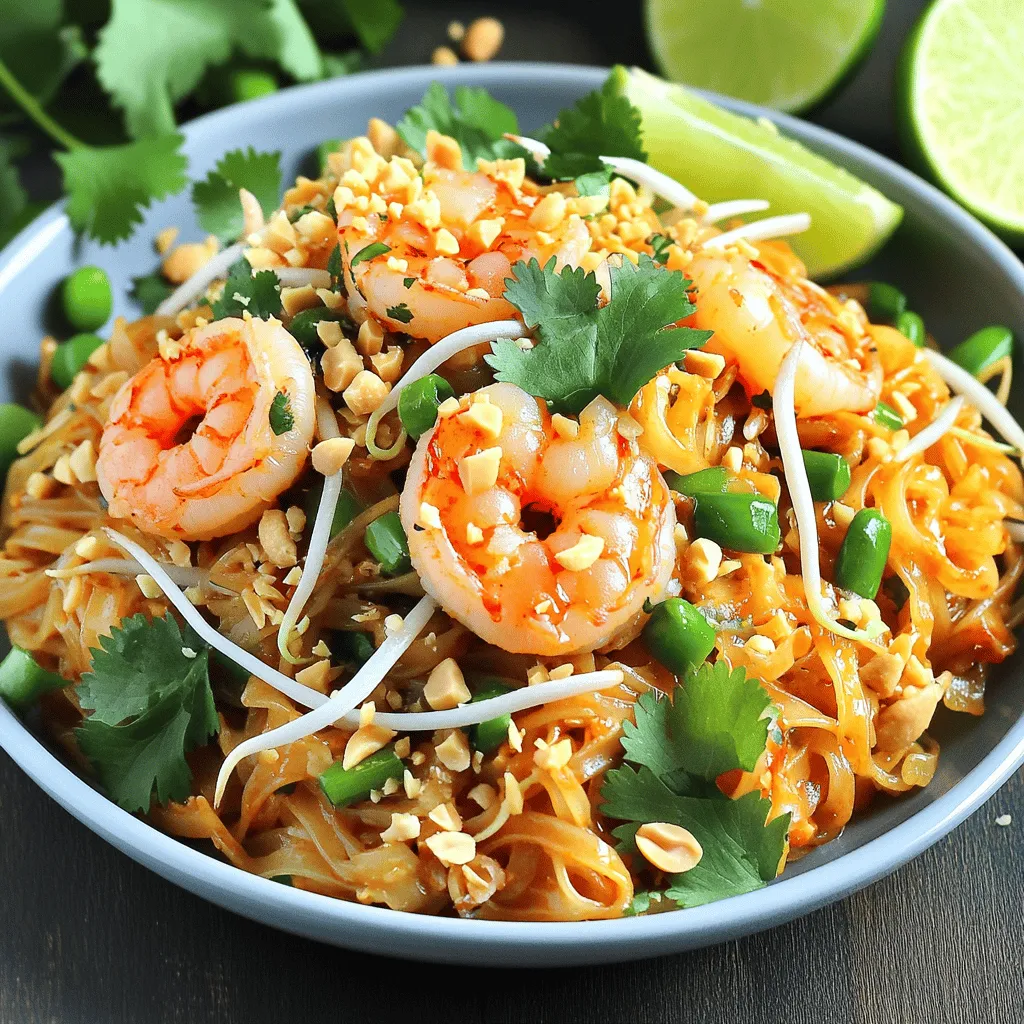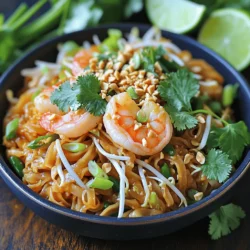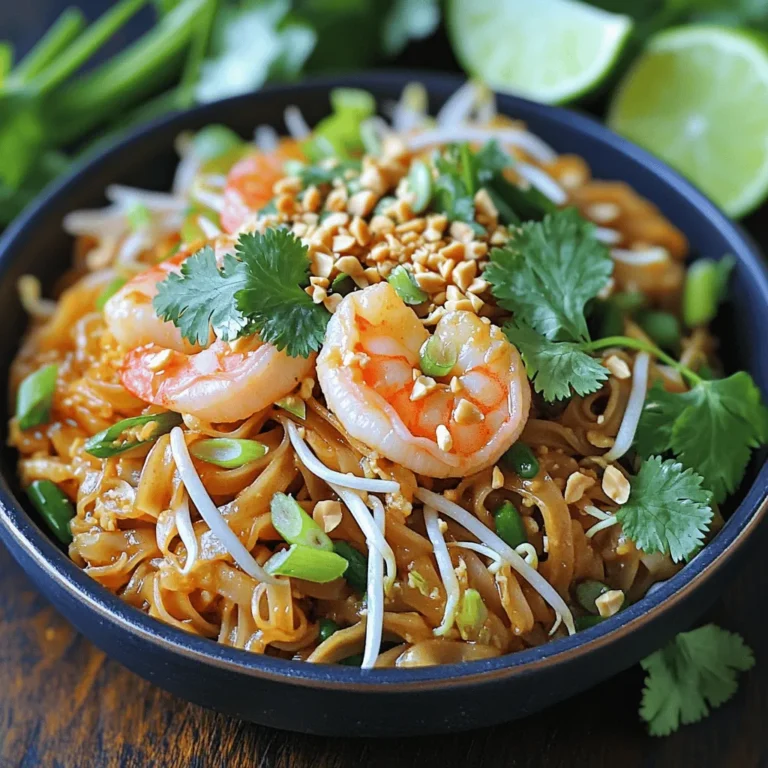Are you craving a quick and tasty meal? My Easy Pad Thai with Shrimp is the perfect solution! This flavorful dish comes together in just 30 minutes, making it ideal for busy weeknights. With simple ingredients and step-by-step instructions, you’ll be amazed at how easy it is to whip up this classic Thai dish. Get ready to impress your taste buds and your family with this delicious recipe that’s both satisfying and fun to make!
Ingredients
Main Ingredients
– 8 ounces rice noodles
– 1 pound shrimp, peeled and deveined
– 2 large eggs, lightly beaten
– 1 cup fresh bean sprouts
Flavoring Ingredients
– 3 tablespoons fish sauce
– 1 tablespoon tamarind paste
– 2 tablespoons brown sugar
– Juice of 1 lime
Garnish and Optional Ingredients
– Chopped roasted peanuts
– Fresh cilantro leaves
– Red pepper flakes (optional, for heat)
When preparing this easy Pad Thai with shrimp, it helps to gather all your ingredients first. This makes cooking smoother and faster. The main ingredients, such as rice noodles and shrimp, are key. Rice noodles give the dish its signature texture. Shrimp adds protein and a sweet flavor. The eggs and bean sprouts bring richness and crunch.
For flavor, fish sauce, tamarind paste, brown sugar, and lime juice are essential. Fish sauce gives a salty umami taste. Tamarind adds a unique tanginess. Brown sugar balances the flavors with sweetness. Lime juice brightens everything up.
Lastly, don’t forget the garnish! Chopped roasted peanuts add crunch. Fresh cilantro gives a fresh taste. If you like heat, sprinkle in some red pepper flakes. These simple ingredients come together to create a delightful dish.Enjoy cooking!
Step-by-Step Instructions
Preparing the Noodles
Start by cooking the rice noodles. Follow the package instructions carefully. Once they are soft, drain them in a colander. Rinse the noodles under cold water to stop the cooking. This keeps them from getting mushy. Set the noodles aside for later.
Sautéing Preparatory Ingredients
Next, heat one tablespoon of vegetable oil in a large skillet. Use medium-high heat. Add one clove of minced garlic. Sauté it for about 30 seconds. You want it fragrant and golden. Be careful not to burn the garlic. After that, add one pound of peeled and deveined shrimp. Cook the shrimp for 2-3 minutes. They should turn pink. Once done, remove the shrimp from the skillet and keep them warm on a plate.
Cooking and Combining Ingredients
Now, let’s move on to the eggs. In the same skillet, pour in two large, lightly beaten eggs. Let them cook without stirring for a little bit. After a minute, scramble the eggs gently with a spatula. Once they are fully cooked, push them to one side of the skillet.
Next, mix in the cooked rice noodles, shrimp, one cup of fresh bean sprouts, and three chopped green onions. Toss everything together gently. This helps to spread the flavors evenly.
Now, we create the sauce. In a small mixing bowl, whisk together three tablespoons of fish sauce, one tablespoon of tamarind paste, two tablespoons of brown sugar, and the juice of one lime. Once well-mixed, pour this sauce over the noodle mixture in the skillet. Toss everything again to coat the ingredients well.
Finally, let everything cook together for another 2-3 minutes. This allows the flavors to meld. If you like some heat, sprinkle in red pepper flakes to taste.
Your Easy Pad Thai with Shrimp is ready to serve!
Tips & Tricks
Perfecting the Pad Thai
To cook shrimp just right, heat your skillet over medium-high. Add the shrimp and sauté for 2-3 minutes until they turn pink. If you cook them too long, they’ll become rubbery. Remove shrimp right away to keep them tender.
For noodles, stick to this method: cook rice noodles according to the package. After cooking, rinse them under cold water. This stops the cooking process and helps keep them from sticking together. Toss them lightly with a bit of oil if needed.
Ingredient Substitutions
If shrimp isn’t your thing, you can use tofu or chicken instead. Tofu should be firm and cubed, while chicken can be sliced thinly. Just remember to adjust the cooking time.
For those needing a gluten-free option, look for rice noodles labeled gluten-free. You can also substitute tamari for fish sauce if you want a soy-based flavor.
Serving Suggestions
To make your Pad Thai look amazing, use shallow bowls. Garnish with chopped peanuts and cilantro for color. Lime wedges on the side add a fresh touch.
Pair your Pad Thai with a light salad or spring rolls for a full meal. This adds balance and keeps it light yet satisfying. For more options, you can explore different side dishes that enhance the flavors of the dish.

Variations
Vegetarian Pad Thai
You can easily make a vegetarian Pad Thai. Simply swap the shrimp for tofu or more veggies. Firm tofu works best, as it adds texture. Cut the tofu into cubes and pan-fry it until golden. You can also add bell peppers, carrots, and zucchini for a colorful dish. This mix will give you great flavor and crunch.
Spicy Pad Thai
If you love heat, a spicy Pad Thai is for you. Just add more red pepper flakes to your dish. You can also include spicy ingredients like sliced chili peppers or sriracha. This will make your meal bold and exciting. Be careful not to overdo it, though! Start with a little and taste as you go.
Tofu Pad Thai Options
Tofu comes in many forms, each with its own texture. Silken tofu is soft and great for blending, while firm tofu holds its shape. For the best flavor, marinate your tofu in the sauce before cooking. Sauté it until it’s golden brown. This brings out its taste and makes it a hearty option in your Pad Thai.
Storage Info
Storing Leftovers
To keep your Pad Thai fresh, use airtight containers. Glass or BPA-free plastic containers work best. Let the dish cool down before sealing it. This helps prevent moisture buildup, which can make your noodles soggy. Place the container in the fridge. Your Pad Thai can stay fresh for up to three days. Always label your containers with dates for easy tracking.
Freezing Instructions
If you want to save Pad Thai for later, freezing is a great option. First, let the dish cool completely. Then, portion it into freezer-safe bags or containers. Remove as much air as possible before sealing to avoid freezer burn. Your Pad Thai can last up to three months in the freezer. To reheat, thaw it overnight in the fridge. Then, warm it on the stove over medium heat. Add a splash of water to help separate the noodles.
Shelf Life
In the fridge, Pad Thai lasts about three days. In the freezer, it stays fresh for three months. Always check for signs of spoilage before eating. If it smells off or looks strange, throw it out. Enjoy your tasty meals safely!
FAQs
How do I prevent my noodles from sticking together?
Sticky noodles can ruin your Pad Thai. Sticky noodles often happen due to overcooking or not rinsing them. Here are some tips to keep your noodles perfect:
– Cook carefully: Follow the package directions for cooking time. Aim for al dente.
– Rinse after cooking: Drain your noodles in a colander. Rinse them under cold water to stop the cooking.
– Toss with oil: After rinsing, toss the noodles with a little oil. This helps keep them separate.
Can I use other types of protein in Pad Thai?
Yes, you can use many proteins in Pad Thai! Here are some great options:
– Tofu: Use firm tofu, cut into cubes. Cook it until golden.
– Chicken: Slice chicken breast thinly. Cook it until no pink remains.
– Beef: Use flank steak or sirloin, sliced thin. Cook it quickly for tenderness.
– Pork: Thinly slice pork tenderloin. Cook it until browned and cooked through.
Adjust cooking times based on the protein you choose.
What is tamarind paste and can I substitute it?
Tamarind paste is a tangy and sweet ingredient from tamarind pods. It adds depth to Pad Thai. If you can’t find it, try these substitutes:
– Soy sauce: Use soy sauce for saltiness, but it won’t add the same tang.
– Lime juice: Mix lime juice with a little brown sugar for a similar flavor.
– Vinegar: Rice vinegar can work too, but it may taste different.
How can I make Pad Thai gluten-free?
Making gluten-free Pad Thai is simple with the right choices. Here are some tips:
– Noodles: Use rice noodles, which are naturally gluten-free.
– Sauce: Substitute fish sauce with gluten-free soy sauce or tamari.
– Check labels: Always check labels on sauces for gluten-free options.
With these changes, you can enjoy a delicious gluten-free Pad Thai!
Pad Thai is a dish full of flavor and fun. We explored its main ingredients, like rice noodles and shrimp, and discussed how to cook them perfectly. Remember the key tips for silky noodles and flavorful sauce to enhance your dish. You can also try fun variations, like vegetarian or spicy options. With proper storage, your Pad Thai stays fresh and delicious. Create a unique meal that satisfies your taste buds and impresses your friends. Enjoy cooking, and don’t hesitate to experiment!


